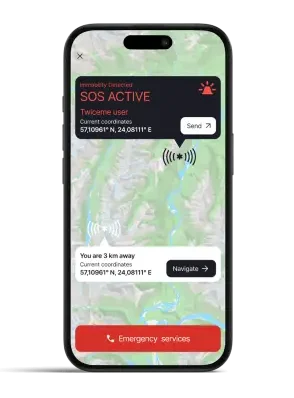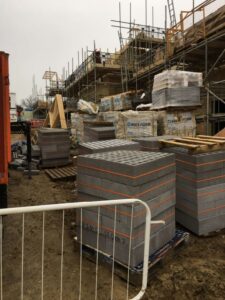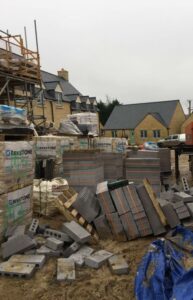If you’re responsible for safety in the field, you’ll know that the pressure is real. Regulations are tightening, timelines are shrinking, and dispersed teams make it harder to stay responsive. Throw in outdated systems and unpredictable schedules, and things get even tougher.
At Fluix, we work with field-first teams across high-risk industries to improve safety management, digitise inspections, and strengthen compliance. We’ve seen firsthand how safety tech is transforming fieldwork, and we know what’s driving results. Here’s our take on the 8 trends to watch.
1. Digital Transformation in Field Industries Means Starting With the Basics
Digital transformation might sound ‘big’, but for field-based safety teams, it starts small. Replacing paper forms and admin with digital tools and smart workflows can unlock serious gains.
Take inspections and incident reports for example. Moving these off clipboards and onto devices means issues can be flagged and escalated on the spot. There’s no waiting for paperwork to make its way back to the office. Smart forms can auto-fill known info, guide users step by step, and trigger follow-ups instantly.
By digitising safety checklists, ZITON cut completion time by 72% and improved reporting speed by more than 3.5x. They’re now saving two hours a day with automated document workflows. And it’s only one of the solutions for improving safety you can get with the right tech.
Of course, not every team is starting from the same place. Explore how teams in construction and aviation are making the shift, using platforms like Fluix, and see how getting the basics right sets teams up for success.
2. Safety Workflows Become Super Streamlined, Thanks To Hyperautomation
If your health and safety processes still rely on paper or disconnected systems, critical details probably fall through the cracks. Delayed incident logging, missed follow-ups, and patchy data slow things down and raise risk. In high-stakes environments, that can mean overlooked hazards or non-compliance.
Digital tools are already enabling real-time incident reporting and visibility across teams and sites, and hyperautomation takes things further. By linking AI, IoT sensors and mobile workflows, systems become super-intelligent.
Picture this: A technician logs a hazard onsite, and the system automatically alerts a supervisor, schedules a follow-up, logs compliance data, and updates dashboards. There’s not one single manual handoff required, no delays, and no human error.
Hyperautomation has already gained traction in energy, construction, and manufacturing, but rolling it out takes planning. With clean data, the right tools, and clear processes, the upsides are huge.
3. Smart Wearables Raise the Bar for Real-Time Risk Detection
Smart PPE no longer looks like it belongs in a sci-fi movie. With more companies investing in wearable safety tech, it is becoming standard on job sites, plant floors, and in remote field operations. Early versions were bulky and limited, but today’s models are lighter, smarter, and built for real-world conditions. Field workers can wear them whether they’re climbing turbines, inspecting confined spaces, or managing long shifts in extreme environments.
Real-time responsiveness is what sets this equipment apart. Smart helmets, vests, wristbands, and ID badges contain sensors that track worker location, movement, gas exposure, temperature, and even heart rate. If something’s off – say somebody experiences a drop in oxygen or shows signs of heat stress – the system can trigger alerts and notify people immediately.
For safety teams, that means faster reactions and earlier intervention. A lone worker in trouble can silently call for help, or flag overexertion before it becomes a problem. Catching these moments early can stop an incident in its tracks.
4. AI Assistants Make Field Work Safer
AI assistants are gaining ground across industries, and safety is no exception. They can accompany a technician, flagging risks, surfacing checklists, and suggesting corrective actions, without digging through manuals or pausing to seek guidance.
Imagine a fieldworker in a turbine tower, where air quality needs constant monitoring. If oxygen levels drop or gas readings spike, an AI assistant can step in, pulling up hazard control procedures, and prompting a stop-work action before things escalate. Real-time support like this can help field teams react fast, follow protocol, and avoid serious incidents.
This isn’t future-gazing. AI is already helping frontline teams work smarter. In oil and gas, companies like ExxonMobil and Chevron use it to manage operations remotely and cut emissions. In manufacturing, Cisco’s 2024 report found AI-enabled devices are the top investment priority. And in the UK, firms like Amey are using it to give frontline staff instant access to critical information. Expect to see AI rolled out across all field industries in the months ahead.
5. Immersive Training Takes Safety to the Next Level
Let’s be honest – traditional safety training often falls short. Slide decks and static e-learning modules can feel like box-ticking exercises rather than real preparation. In high-risk environments, this lack of engagement is dangerous.
Now, AR and VR are revolutionizing safety training by placing workers in realistic high-risk scenarios without real-world danger. Before setting foot on a job site for instance, a new recruit in a high-rise construction project can simulate scaffolding work ten stories up, understanding risks and practicing procedures in advance.
Being one of the most dynamic field productivity trends in recent years, еhis approach is extra valuable in fields where errors are costly.
Immersive training experiences enhance muscle memory and improve hazard awareness, and AI can be used to evaluate trainee performance in real time. It can identify weaknesses and tailor future programmes to close knowledge gaps, before they become field issues.
Beyond training, AR aids safety teams when they’re actually on the job. With smart glasses, technicians get step-by-step guidance directly in their view, which is crucial for inspections and complex tasks. This tech reduces errors, shortens task times, and supports remote operations, even in isolated areas.
Adoption challenges like cost and connectivity exist, but the direction is clear. Safety teams aiming to raise standards will soon find immersive tech indispensable.
6. Mobile Tools Keep Safety Work Moving – Even Offline
In field industries, safety tasks don’t happen behind a desk. You’re out at job sites, often in areas where connectivity is spotty. Mobile-first safety tools have become essential for keeping teams responsive and operations compliant. In fact, according to a 2024 Verdantix report, mobile EHS applications are booming due to the need for real-time data capture and offline functionality in remote or hazardous environments.
With solutions like Fluix, teams can conduct safety inspections, complete analyses, capture incident details, and initiate corrective action – all without signal. Data syncs automatically when they’re back online, so there are no delays in reporting, no lost paperwork, and no breaks in audit trails. This keeps frontline teams connected and aligned, even when they’re miles apart.
For example, during a high-voltage line inspection, a field technician can use a mobile device to tick off a safety checklist, snap pictures of equipment, and flag any hazards right then and there. If the signal’s out, it’s not a problem. The data gets saved and uploads automatically once they’re back online, so the safety manager at HQ gets the updates without a hitch.
“The fact that you can use Fluix offline is an absolute must for us,” says James Bird, Maintenance Engineer at RWE Renewables. “It means technicians can work on a boat, from their car, or from the top of a turbine.”
7. Predictive Safety Analytics Stop Incidents Before They Happen
Safety teams have been collecting data for a long time, but now predictive analytics turn it into action. Instead of sifting through spreadsheets, progressive HSE professionals are using tools that spot trends and flag issues faster. Whether it’s identifying fatigue in shift workers, early wear in equipment, or high-risk zones, teams can act sooner to reduce incidents.
Imagine sensors in PPE detecting a trend in elevated body temperature and heart rate, triggering an alert for potential heat stress. Or site data showing near misses at a specific time, prompting a review of scheduling.
With tighter regulations, like OSHA’s 2024 rule for digital injury and illness data from large high-risk sector companies, the push is on – not just to record safety events, but to prevent them.
8. Smarter Scheduling and Route Optimization Redefine Field Productivity
Gone are the days of static plans and manual dispatch. Today’s teams need flexibility when safety’s on the line. Smart task scheduling uses live data, like technician location, skills, job urgency, traffic, and weather, to assign tasks in real-time, ensuring the right person gets there quickly, with minimal risk.
Route optimization is a safety game-changer. Less road time means less fatigue and fewer vehicle risks, allowing more focus on critical tasks. For crews handling urgent issues like equipment failures or storm damage, optimizing routes in the moment can significantly enhance safety outcomes.
While the tech is ready, implementing it is the next hurdle. With accurate data, connected systems, and prepared teams, dynamic scheduling and route optimization is set to supercharge safety and efficiency in the field.
In Short, Safety Leaders Need To Adapt To And Embrace Innovation
The next generation of safety tools is here, and it’s revolutionizing how field industries operate. The opportunity goes beyond digitization. These resources simplify, connect, and empower. While planning ahead can be tough during unpredictable times, one thing is clear: By leading your team through technological change and embracing innovation, they’ll be fully future-ready.
At Fluix, we create tools that help field-first safety teams boost efficiency. Whether it’s inspections, audits, or compliance tasks, our platform keeps work flowing and teams aligned, even off the grid. Ready to see how the right tech can make your safety processes faster, smarter, and more resilient? Visit fluix.io to learn more or connect with us on LinkedIn to join the conversation.











 A new standard for sun safety
A new standard for sun safety
 Origami Risk, the industry-leading risk, safety and insurance Software as a Service (SaaS) technology firm, achieved the highest client satisfaction score among vendors profiled in the 2025 RMIS Report, released this week by Redhand Advisors, a risk management technology consulting firm. This marks the sixth consecutive year Origami has earned this distinction.
Origami Risk, the industry-leading risk, safety and insurance Software as a Service (SaaS) technology firm, achieved the highest client satisfaction score among vendors profiled in the 2025 RMIS Report, released this week by Redhand Advisors, a risk management technology consulting firm. This marks the sixth consecutive year Origami has earned this distinction.





